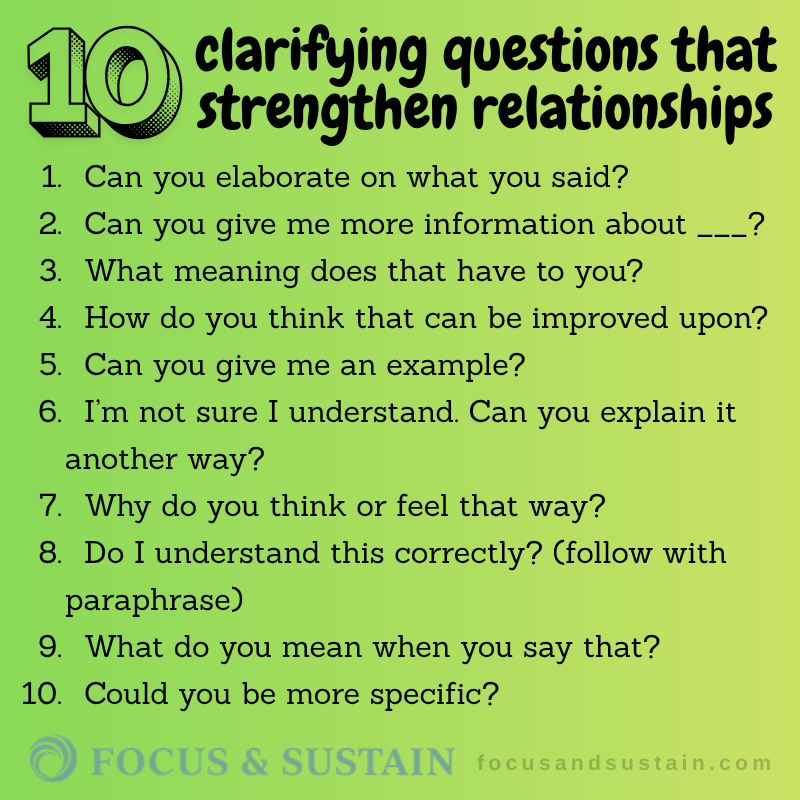How Clarifying Questions Build Trust and Effective Communication
Communication is the foundation of all human interaction. Whether you’re discussing a yearly budget with your spouse, addressing the future of the family business, or haggling at the local flea market, effective communication tactics (such as asking clarifying questions) typically deliver favorable results. And, of course, let’s not forget that failing to communicate can have devastating consequences.
For instance, 65% of mental health experts name communication issues as the leading cause of divorce. On the flip side, couples who intentionally improve their communication skills through counseling or other means are 30% more likely to report higher levels of relationship satisfaction.
What’s more, positive communication trends extend to platonic or familial relationships. So, naturally, honing one’s communication skills can profoundly impact every facet of life.
Luckily, there is an easy way to improve your communication skills, leading to increased trust in your valued relationships. Want to know the secret? It’s simple: start asking clarifying questions.
What are clarifying questions?
Clarifying questions are follow-up questions used during conversation to gain a better understanding of what someone has said. They’re often asked when something is vague, ambiguous, or open to multiple interpretations. Rather than assuming meaning, the listener practices effective communication and asks for more detail or context to ensure they’ve correctly understood the speaker’s intention.
Two Types of Clarifying Questions
Clarifying questions generally fall under two categories:
-
- Validation questions are intended to clarify or affirm specific pieces of information to gain confirmation that the listener heard the speaker accurately.
- Open-ended questions are more generalized and aimed at drawing out additional information or prompting the speaker to continue with their train of thought or story.
Why clarifying questions build trust
First and foremost, asking clarifying questions simply shows that you care about what the speaker is saying. Not only are you actively listening, but you want to fully understand all context and avoid misunderstandings. Promoting this open environment creates the space for honest, respectful, and effective communication. It levels the playing field and indicates a collaborative, not critical, intent.
How do clarifying questions lead to effective communication
Effective communication starts when everyone is on the same page; there’s nothing that hinders communication more than playing the guessing game. People commonly assume they understand each other without checking first. When we aren’t 100% clear about something, we tend to fill in the blanks with our own interpretations—interpretations that are often inaccurate.
Clarifying questions help stop the guessing game by replacing assumptions with real understanding, which can be especially useful during complex or emotionally charged conversations.
It’s also no secret that effective communication starts with good listening. A 2016 Harvard Business Review article uses a fantastic metaphor to describe what a good listener actually does:
While many of us have thought of being a good listener being like a sponge that accurately absorbs what the other person is saying, instead, what these findings show is that good listeners are like trampolines. They are someone you can bounce ideas off of — and rather than absorbing your ideas and energy, they amplify, energize, and clarify your thinking. They make you feel better not merely passively absorbing, but by actively supporting. This lets you gain energy and height, just like someone jumping on a trampoline.
The same article describes six levels of listening. The highest level involves asking clarifying questions to help provide additional insight without “hijacking” the conversation.
To learn more about how to have effective communication, check out Bhaj’s blog article, The 4 Keys to Trusted Communication.
10 clarifying questions that strengthen relationships
Clarifying questions can focus on the meaning of specific words, the reasoning behind a statement, or the emotions someone is expressing. Here are some examples:

How to ask clarifying questions
In order to ask clarifying questions, you need to be listening attentively. A reliable place to start is to ask yourself, “What don’t I understand? What would I like to know more about?”
“Ask clarifying questions when you don’t understand the other person’s point or perspective, without judgment.” — Bhaj Townsend
It’s important to remember that clarifying questions are not about being critical or corrective. Leave your opinion out of it. Your goal is to understand and provide support.
Common Questions About Clarifying Questions and Effective Communication
Why is it important to ask clarifying questions?
Asking clarifying questions prevents misunderstandings and displays genuine curiosity. It shows that you’re actively listening and care about getting the full picture. By seeking clarity, you build trust and create space for more thoughtful, effective dialogue.
What does it mean to be an effective communicator?
Being an effective communicator means expressing your thoughts clearly while also listening with the intent to understand. Asking and answering clarifying questions is a key element of effective communication.
If you want more guidance on asking clarifying questions and strengthening your communication skills, contact F&S expert Bhaj Townsend via email at bhaj@focuasandsustain.com.

